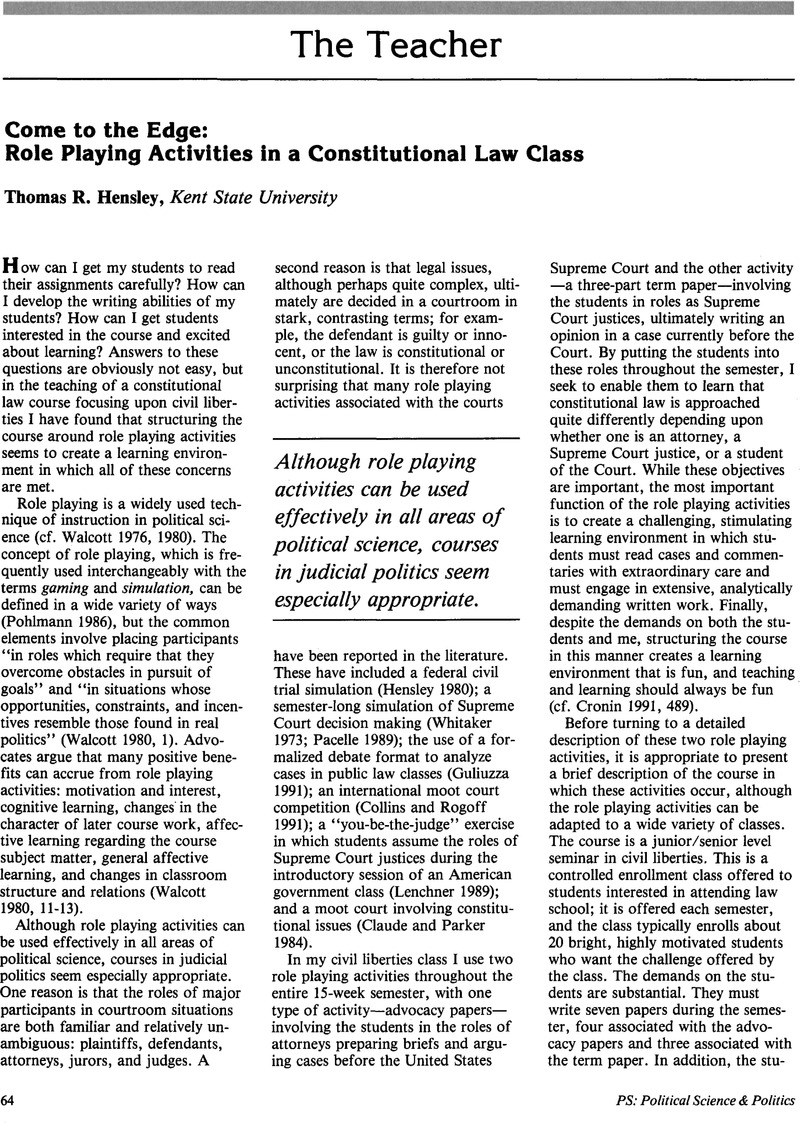Crossref Citations
This article has been cited by the following publications. This list is generated based on data provided by Crossref.
Kaarbo, Juliet
and
Lantis, Jeffrey S.
1997.
Coalition Theory in Praxis: A Comparative Politics Simulation of the Cabinet Formation Process.
PS: Political Science & Politics,
Vol. 30,
Issue. 3,
p.
501.
Brock, Kathy L.
and
Cameron, Beverly J.
1999.
Enlivening Political Science Courses with Kolb's Learning Preference Model.
PS: Political Science & Politics,
Vol. 32,
Issue. 2,
p.
251.
Roper *, Steven D.
2004.
Teaching students how to be revolutionaries or reformers: a course simulation.
Innovations in Education and Teaching International,
Vol. 41,
Issue. 3,
p.
245.
Kiasatpour, Soleiman
and
Whitfield, Christopher
2008.
Politics in Action: Wolves, Snowmobiles, and Bison and
the Greater Yellowstone Ecosystem.
PS: Political Science &
Politics,
Vol. 41,
Issue. 1,
p.
193.
Fliter, John
2009.
Incorporating a Sophisticated Supreme Court Simulation into an Undergraduate Constitutional Law Class.
Journal of Political Science Education,
Vol. 5,
Issue. 1,
p.
12.
Sands, Eric C.
and
Shelton, Allison
2010.
Learning by Doing: A Simulation for Teaching How Congress Works.
PS: Political Science & Politics,
Vol. 43,
Issue. 1,
p.
133.
Raymond, Chad
2010.
An Experiment in Teaching International Relations: The Effects of a World War I Role-Playing Simulation on Student Performance.
SSRN Electronic Journal,
Smith, Daniel E.
2010.
Mini-Moot Court: Use of the Abbreviated Simulation in Teaching Constitutional Law.
SSRN Electronic Journal,
Smith, Daniel E.
2012.
Incourt: Using a Virtual Supreme Court to Enhance the Traditional Simulation Experience.
SSRN Electronic Journal,
Raymond, Chad
2012.
Missing the Trees for the Forest?: Learning Environments Versus Learning Techniques in Simulations.
Journal of Political Science Education,
Vol. 8,
Issue. 1,
p.
69.
Cooperman, Rosalyn
2012.
Lawmaking and Law Interpreting in the Land of Oz: Using Simulations to Draw Back the Curtains of the American Legislative and Judicial Processes.
SSRN Electronic Journal,
Smith, Daniel E.
2013.
Student Engagement on the Cheap: Small-Scale Active Learning Components in the American Government Course.
SSRN Electronic Journal,
Biziouras, Nikolaos
2013.
Bureaucratic Politics and Decision Making Under Uncertainty in a National Security Crisis: Assessing the Effects of International Relations Theory and the Learning Impact of Role-Playing Simulation at the U.S. Naval Academy.
Journal of Political Science Education,
Vol. 9,
Issue. 2,
p.
184.
Bridge, Dave
2013.
The Settlement Game: A Simulation Teaching Institutional Theories of Public Law.
PS: Political Science & Politics,
Vol. 46,
Issue. 04,
p.
813.
Raymond, Chad
and
Usherwood, Simon
2013.
Assessment in Simulations.
Journal of Political Science Education,
Vol. 9,
Issue. 2,
p.
157.
Gates, John B.
2013.
Using an Online Simulation of Supreme Court Decision Making In Large Classes.
SSRN Electronic Journal,
Blings, Steffen
and
Maxey, Sarah
2017.
Teaching Students to Engage with Evidence: An Evaluation of Structured Writing and Classroom Discussion Strategies.
Journal of Political Science Education,
Vol. 13,
Issue. 1,
p.
15.
McGee, Zachary A.
and
Hall, Precious D.
2024.
Using Prediction Markets as a Tool for Classroom and Civic Engagement.
Journal of Political Science Education,
p.
1.



